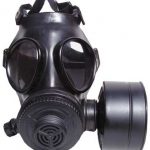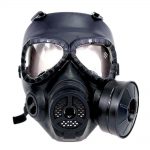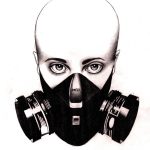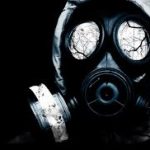The gas mask was used to protect the user from breathing in airborne pollutants and toxic gases. It forms a sealed cover over the whole face protecting the eyes, mouth and nose. The gas mask does not protect the skin from absorbing gas, the filers for a gas mask will usually last around 24 hours in a nuclear biological chemical situation.
In WW1, the most common gas toxins were Sulfur Mustard and Chlorine Gas or particulates such as biological agents developed for weapons such as bacteria, viruses and toxins. The traditional gas mask style was with two small circular eye windows originated when the only suitable material for these windows was glass or acrylic. Glass is notoriously brittle so the windows has to be kept small and thick. The discovery of poly carbonate allowed for the gas mask to have a large full-face window. The gas mask usually have one or two filters attached to the mouth part of the mask and some masks have the filter connected to a hose.
Principles of Construction:
The word absorption is the process of being drawn into a body or substrate and the word adsorption is the process of deposition upon a surface. This ca be used to remove both particulate and gaseous hazards however some form of reaction may take place, it is not necessary but the method may work by attractive charges. If the target particles are positively charged, a negatively charged substrate may be used. Examples of substrates are activated carbon and zeolites. Using a damp cloth to cover the mouth and nose while escaping a fire can be very effective, however it does not filter out toxic gas.
Safety of old gas masks:
Gas masks have a limited lifespan which depend on the absorbent capacity of the filter. Once the filter is filled with hazardous chemicals, it stops providing the protection needed. The filter will also degrade with age and if exposed to heat and moisture.
WWII masks contain blue asbestos in their filters, breathing in this in the gas mask factories results in the death of 10% of the employees. Modern gas masks do not use asbestos but you must be careful wearing one.
Filter Classification:
Each filter is selected according to the toxic compound and they each protect against a particular hazard:
- AX – Low-boiling and organic compounds
- A – High-boiling and organic compounds
- B – inorganic gases (hydrogen sulfide, chlorine, hydrogen cyanide)
- E – Sulfur Dioxide and Hydrogen Chloride (acidic gases)
- K – Ammonia and amines
- CO – Carbon Monoxide
- Hg – Mercury
- Reactor – Iodine and Methyl Iodide (radioactive)
- P – Particles, classified as P1, P2 and P3 according to removal efficiency
- ABEK, ABEK-P3, ABEK-HgP3 or other combination filters against multiple hazards.
Use:
Modern gas masks are constructed from an elastic polymer which come in various sizes. They are fitted with adjustable straps. The filter cartridge is fitted near the mouth either directly or via a hose. Many are connected to drinking tubes which can be fitted onto a water bottle.
The masks are rigorously tested using challenge agents such as Isoamyl acetate, a synthetic banana flavourant and camphor which is often used as innocuous challenge agents.
History and development:
The common sponge was used in ancient Greece as a gas mask. A rudimentary gas mask was created in the 9th century by the Banu Musa brothers in Baghdad, Iraq.
Primitive respirators were used by miners and were introduced by Alexander Von Humboldt in 1799. There were also plague doctor’s bird-beak-shaped mask filled with herbs originating from the 17th century.
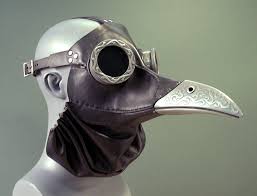
A gas mask which was the basis of the modern gas mask was invented in 1847 by Lewis P. Haslett. It contained elements which allowed the user the breath through a nose and mouthpiece, inhalation through a bulb-shaped filter and a vent to exhale air back into the atmosphere. There were early versions of this mask which were constructed by a Scottish Chemist John Stenhouse in 1854 and a physicist John Tyndall in the 1870s.
The safety hood and smoke protector was invented by Garrett Morgan in 1912 and patented in 1914. It consisted of a cotton hood with two hoses which hung down to the door which allowed the user to breather the safer air found there. Most sponges were inserted at the end of the hoses in order to better filter the air.
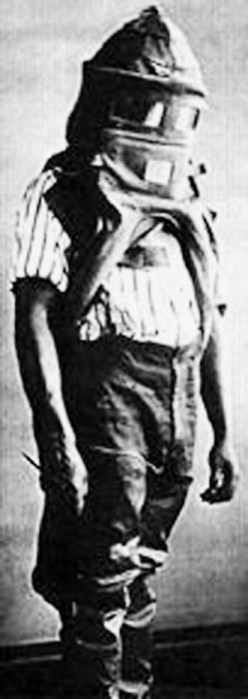
Poisonous gas was first used on the Western Front on April 22 1915 by the Germans at Ypres against Canadian and french colonial troops. The first response to this was to equip the soldiers with cotton mouth pads for protection. Then the British added a long cloth which was used to tie chemical-soaked mouth pads into place, this was called The Black Veil Respirator. This was then developed into the British Hypo Helmet in June 1915.

The canister gas mask followed the hypo helmet, it was a mask connected to a tin can containing the absorbent materials by a hose.

The British Royal Society of Chemistry claims that the British scientist Edward Harrison was the one who developed the first practical gas mask for mass production, this claim was supported by a thank you note written by Winston Churchill.
An American Chemist and inventor called James Bert Garner was credited by the American sources with the invention of the gas mask in April 1915.
The modern gas mask was invented in 1944 by the US Army Chemical Warfare Service. It was made of plastic and rubber like material which greatly reduced the weight and bulk compared to the WW1 masks and it fitted the users face more snugly and comfortably.


